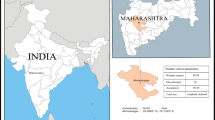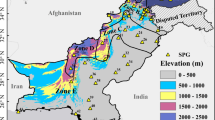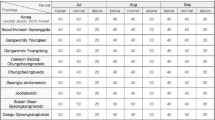Abstract
Precipitation is one of the most important climatic parameters in water resources management. Accurate forecasting of the precipitation occurrence can effectively help to flood risk management, agriculture and irrigation planning, and tourism calendar. In this research, daily precipitation occurrence in Isfahan, Rasht and Tabriz cities (in Iran) with different climates was predicted and evaluated using the meteorological data of prior days. The data set of 2000–2019 (20-years) was applied and the prediction was done using the well-known intelligent methods. Results showed that in Isfahan, the shorter the time lag was (1–3 days), the more effective the parameter “RH” on predicting the daily precipitation was. In the longer the time lag (4–5 days), the more effective was the parameter “T”. In Isfahan, there would be precipitation in four days after the days with Tmax−4 less than 12.93 ºC. Otherwise there would be no precipitation. The decision tree had a precision of about 80.4%. Rasht city, with a very humid climate, has an inverse prediction pattern compared to Isfahan (with arid climate). In Rasht, the shorter the time lag (1–3 days), the more effective was the parameter “T” while, the longer the time lag was (4–5 days), the more effective the parameter “RH” on forecasting the daily precipitation was. In Rasht, precipitation would occur in five days after the days with \({T}_{mean-5}\le 24.87\)ºC. Also, five days after the days with \({RH}_{min-5}\le 49.67\)% precipitation would occur, if \({T}_{mean-5}>24.87\)ºC. Otherwise there would be no precipitation. The precision of the decision tree was 78.9%. In Tabriz, with semi-arid climate, “Sun” (CCI = 65.8%, correctly classified instances) and “Cloud” (CCI = 68.7%) are the most appropriate parameters to forecast the daily precipitation occurrence for the scenarios of the previous 1 and 2 days, respectively. In Tabriz, the longer the time lag (3–5 days), the more effective the parameter “T” on forecasting the daily precipitation was. In Tabriz, precipitation would occur in five days after the days with \({T}_{max-5}\le 25.2\)ºC. If \({T}_{max-5}>25.2\)ºC, then there would be no precipitation in the fifth day. The accuracy of this decision tree was about 62.1%.


Similar content being viewed by others
Data availability
Some or all data used during the study are available from the corresponding author upon reasonable request.
References
Abbasi F, Bazgeer S, Kalehbasti PR, Asadi Oskoue E, Haghighat M, Rezazadeh Kalehbasti P (2022) New climatic zones in Iran: a comparative study of different empirical methods and clustering technique. Theor Appl Climatol 147:47–61
Agnihotri G, Mohapatra M (2012) Prediction of occurrence of daily summer monsoon precipitation over Karnataka. Meteorol Appl 19(2):130–139
Barrera-Animas AY, Oyedele LO, Bilal M (2022) Rainfall prediction: a comparative analysis of modern machine learning algorithms for time-series forecasting. Mach Learn Appl 7:100204
Bhattacharya B, Solomatine DP (2005) Neural networks and M5 model trees in modelling water level-discharge relationship. Neurocomputing 63:381–396
Born L, Prager S, Ramirez-Villegas J, Imbach P (2021) A global meta-analysis of climate services and decision-making in agriculture. Clim Serv 22:100231
Breiman L, Friedman JH, Olshen RA, Stone CJ (1984) Classification and regression trees. Wadsworth, Belmont, CA, USA
Chai SS, Goh KL (2022) Daily rainfall forecasting using Meteorology Data with Long ShortTerm Memory (LSTM) Network. J Optim Ind Eng 15(1):187–193
Chen G, Wang WC (2022) Short-term precipitation prediction for contiguous United States using deep learning. Geophys Res Lett 49:e2022GL097904
Cover TM, Hart PE (1967) Nearest neighbor pattern classification. IEEE Trans Inf Theory IT 13(1):21–27
Freiwan M, Cigizoglu HK (2005) Prediction of total monthly rainfall in Jordan using feed forward backpropagation method. Fresenius Environ Bull 14(2):142–151
Garcia-Salgado BP, Ponomaryov VI, Robles-Gonzalez MA, Robles-Gonzales MA (2016) Parallel multilayer perceptron neural network used for hyperspectral image classification. Proc SPIE 2016(9897):98970K
George J, Letha J, Jairaj PG (2016) Daily rainfall prediction using generalized linear bivariate model-A case study. Proc Technol 24:31–38
Gupta D, Ghose UA (2015) Comparative Study of Classification Algorithms for Forecasting Rainfall. 4th International Conference on Reliability, Infocom Technologies and Optimization
Hassoun MH (1995) Fundamentals of artificial neural networks. MIT Press, London
Islam MJ, Wu QMJ, Ahmadi M, Sid-Ahmed MA (2010) Investigating the performance of Naïve- Bayes classifiers and K-Nearest Neighbor Classifiers. J Converg Inf Technol 5(2):133–137
Katipoglu OM (2021) Estimation of incomplete precipitation data using the adaptive neuro-fuzzy inference System (ANFIS) Approach. Data Sci Appl 4(1):11–15
Katipoglu OM (2023) Evaluation of the performance of data–driven approaches for filling monthly precipitation gaps in a semi–arid climate conditions. Acta Geophys 71:2265–2285
Kisi O, Simen M (2012) Precipitation forecasting by using wavelet-support vector machine conjunction model. Eng Appl Artif Intell 25:783–792
Kumarasiri AD, Sonnadara UJ (2008) Performance of an artificial neural network on forecasting the daily occurrence and annual depth of rainfall at a tropical site. Hydrol Process 22(17):3535–3542
Manandhar S, Dev S, Lee YH (2019) A data-driven approach for accurate rainfall prediction. IEEE Trans Geosci Remote Sens 99:1–9
Mandal S, Choudhury BU (2015) Estimation and prediction of maximum daily rainfall at Sagar Island using best fit probability models. Theor appl Climatol 121(1–2):87–97
Marra F, Koukoula M, Canale A, Peleg N (2024) Predicting extreme sub-hourly precipitation intensification based on temperature shifts. Hydrol Earth Syst Sci 28:375–389
Mekanik F, Imteaz MA, Gato-Trinidad S, Elmahdi A (2013) Multiple regression and artificial neural network for long-term rainfall forecasting using large scale climate modes. J Hydrol 503:11–21
Meque A, Gamedze S, Moitlhobogi T, Booneeady P, Samuel S, Mpalang L (2021) Numerical weather prediction and climate modelling: challenges and opportunities for improving climate services delivery in Southern Africa. Clim Serv 23:100243
Modaresi F, Araghinejad S (2014) A comparative assessment of support vector machines, probabilistic neural networks, and k-nearest neighbor algorithms for water quality classification. Water Resour Manag 28(12):4095–4111
Mohammadi B (2023) Modeling various Drought Time scales via a merged Artificial neural network with a Firefly Algorithm. Hydrology 10:58
Partal T, Cigizoglu HK (2009) Prediction of daily precipitation using wavelet-neural networks. Hydrol Sci J 54(2):234–246
Pham BT, Le ML, Le TT, Bui KTT, Le VM, Ly HB, Prakash I (2020) Development of advanced artificial intelligence models for daily rainfall prediction. Atmos Res 237:104845
Prasad N, Kumar P, MM N (2013) An approach to prediction of precipitation using Gini Index in SLIQ Decision Tree. 4th International Conference on Intelligent Systems, Modelling and Simulation
Quinlan JR (1993) C4.5 programs for machine learning. Morgan Kaufmann, Burlington
Samadianfard S, Mikaeilia F, Prasad R (2023) Evaluation of classification and decision trees in predicting daily precipitation occurrences. Water Supply 22(4):3879
Sattari MT, Rezazadeh Joudi A, Kusiak A (2016) Estimation of Water Quality parameters with Data-Driven Model. Am Water Works Assoc 108(4):232–239
Sattari MT, Shaker Sureh F, Kahya E (2020) Monthly precipitation assessments in association with atmospheric circulation indices by using tree-based models. Nat Hazards 102:1077–1094
Saubhagya S, Tilakaratne C, Mammadov M, Lakraj P (2023) An application of Ensemble Spatiotemporal Data Mining Techniques for rainfall forecasting. Eng Proc 39:6
Shi Y, Chen C, Chen J, Mohammadi B, Cheraghalizadeh M, Abdallah M, Katipoglu OM, Li H, Duan Z (2023) Evaluation of the RF-MEP Method for merging multiple Gridded Precipitation products in the Chongqing City, China. Remote Sens 15:4230
Unnikrishnan P, Jothiprakash V (2020) Hybrid SSA-ARIMA-ANN model for forecasting daily rainfall. Water Resour Manag 34:3609–3623
Weerasinghe HDP, Premaratne HL, Sonnadara DUJ (2010) Performance of neural networks in forecasting daily precipitation using multiple sources. J Natl Sci Found 38(3):163–170
Witten IH, Frank E, Hall MA (2005) Data Mining: practical machine learning tools and techniques. Morgan Kaufmann, Burlington
Wu CL, Chau KW, Fan C (2010) Prediction of rainfall time series using modular artificial neural networks coupled with data-preprocessing techniques. J Hydrol 389(1–2):146–167
Yuan H, Van Der Wiele CF, Khorram S (2009) An Automated Artificial neural network system for Land Use/Land Cover classification from landsat TM imagery. Remote Sens 1:243–265
Funding
The authors declare that no funds, grants, or other support were received during the preparation of this manuscript.
Author information
Authors and Affiliations
Contributions
Conceptualization; Ghorban Mahtabi and Ozgur Kisi; Investigation and Methodology; Ghorban Mahtabi and Saeed Mozaffari ; Project administration and Supervision; Ghorban Mahtabi and Ozgur Kisi; Writing-original draft preparation, Ghorban Mahtabi and Farshid Taran; all authors contributed to reviewing and editing the manuscript. All authors have read and agreed to the published version of the manuscript. All authors contributed to reviewing and editing the manuscript. All authors have read and agreed to the published version of the manuscript.
Corresponding author
Ethics declarations
Competing interests
The authors declare no competing interests.
Additional information
Communicated by: H. Babaie
Publisher’s Note
Springer Nature remains neutral with regard to jurisdictional claims in published maps and institutional affiliations.
Rights and permissions
Springer Nature or its licensor (e.g. a society or other partner) holds exclusive rights to this article under a publishing agreement with the author(s) or other rightsholder(s); author self-archiving of the accepted manuscript version of this article is solely governed by the terms of such publishing agreement and applicable law.
About this article
Cite this article
Mahtabi, G., Kisi, O., Mozaffari, S. et al. Predictive modeling of daily precipitation occurrence using weather data of prior days in various climates. Earth Sci Inform (2024). https://doi.org/10.1007/s12145-024-01289-4
Received:
Accepted:
Published:
DOI: https://doi.org/10.1007/s12145-024-01289-4




